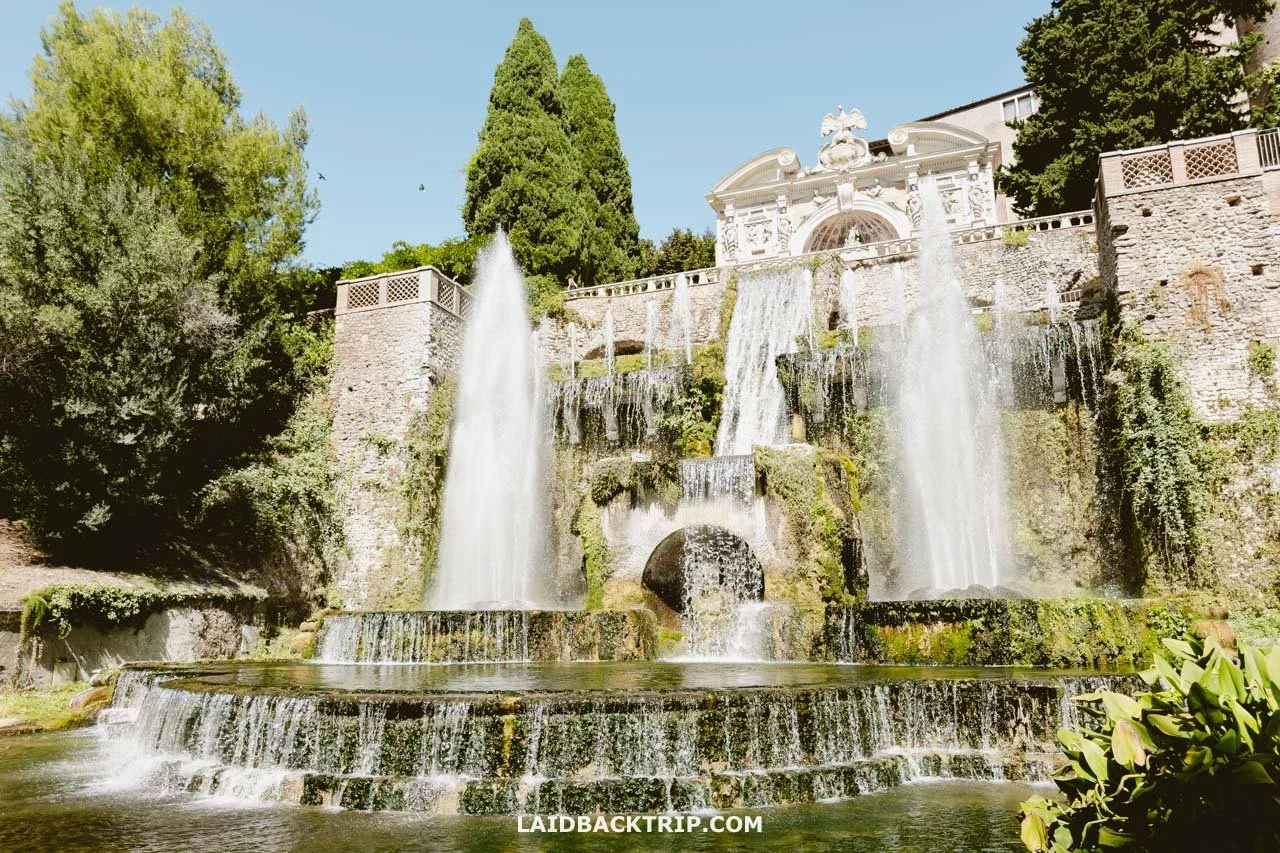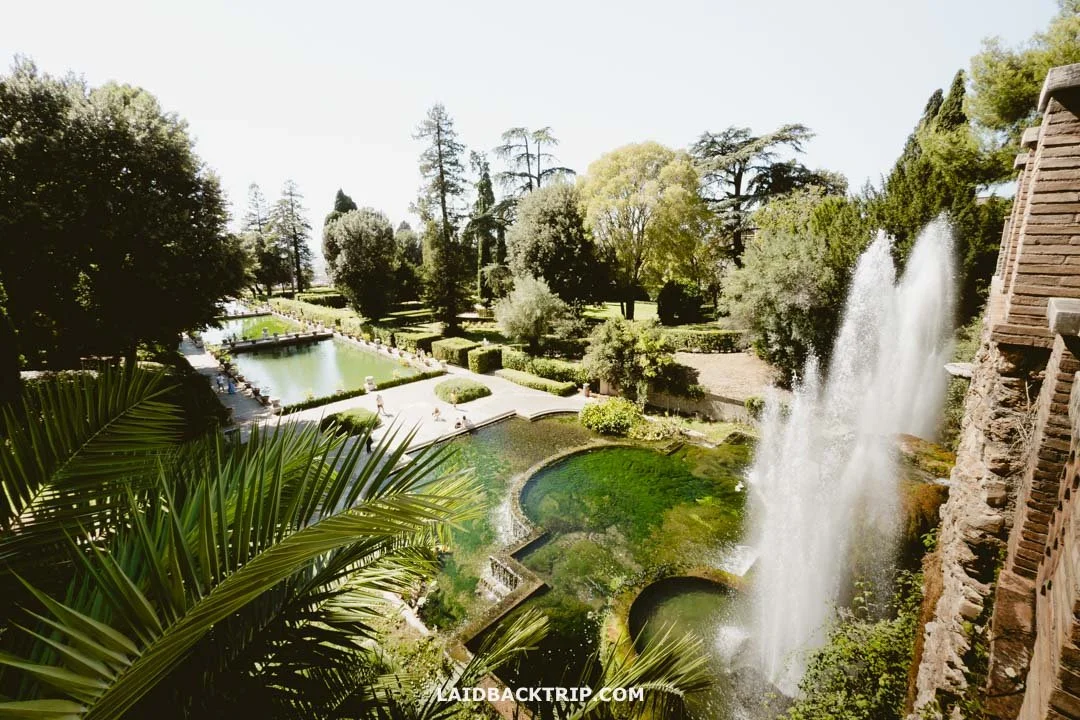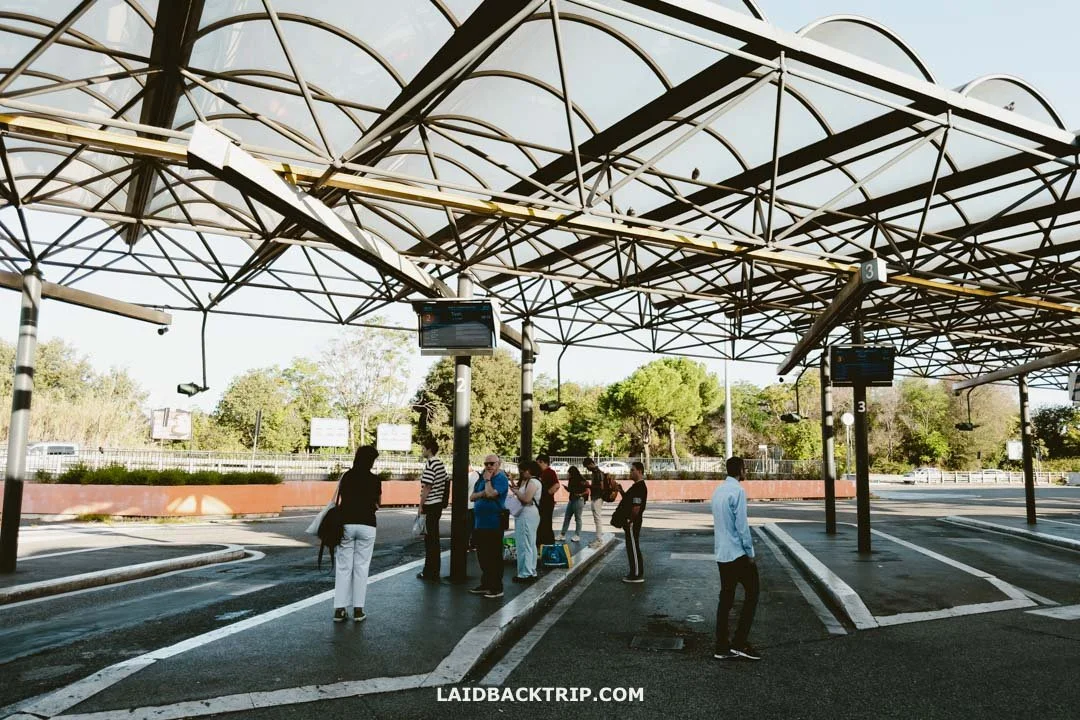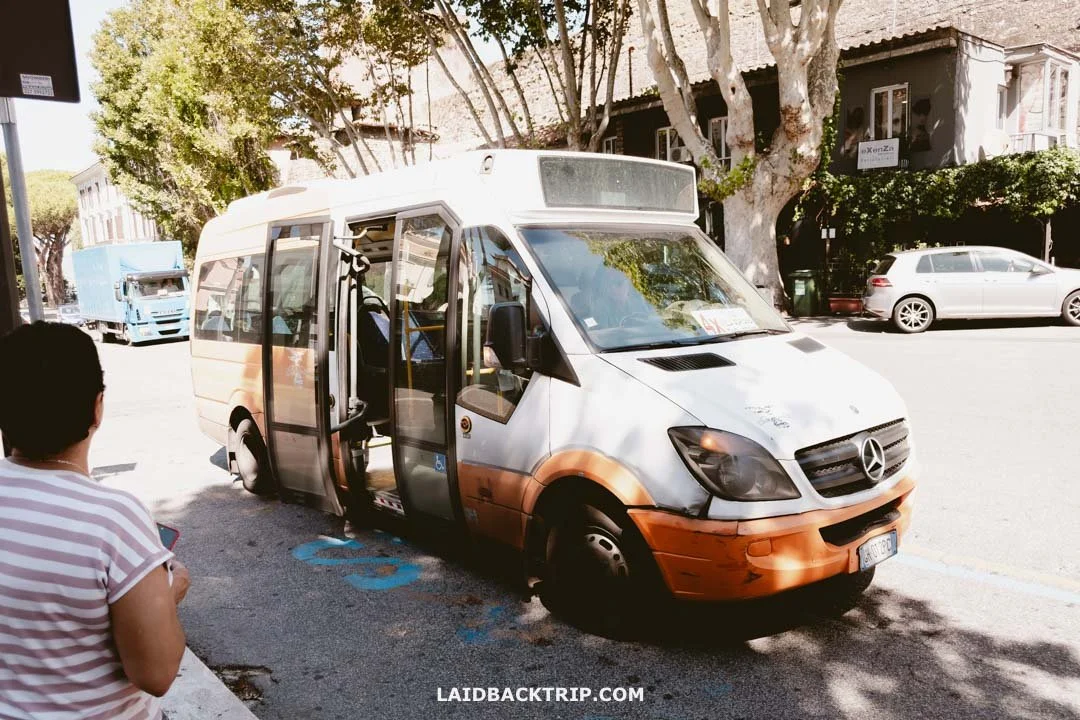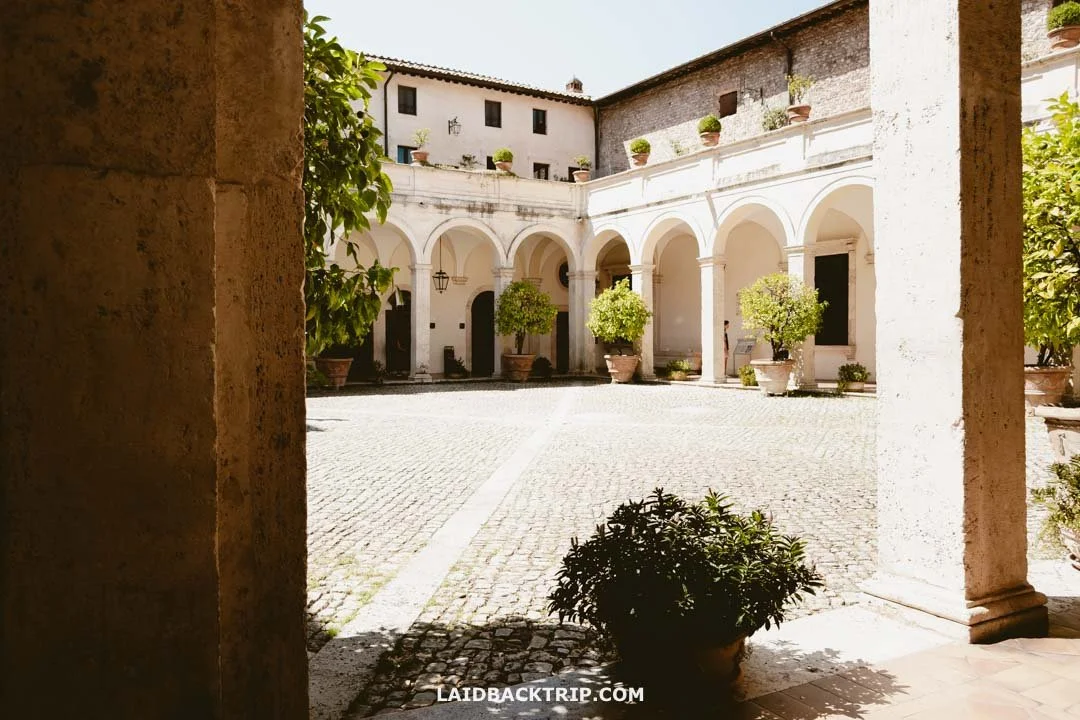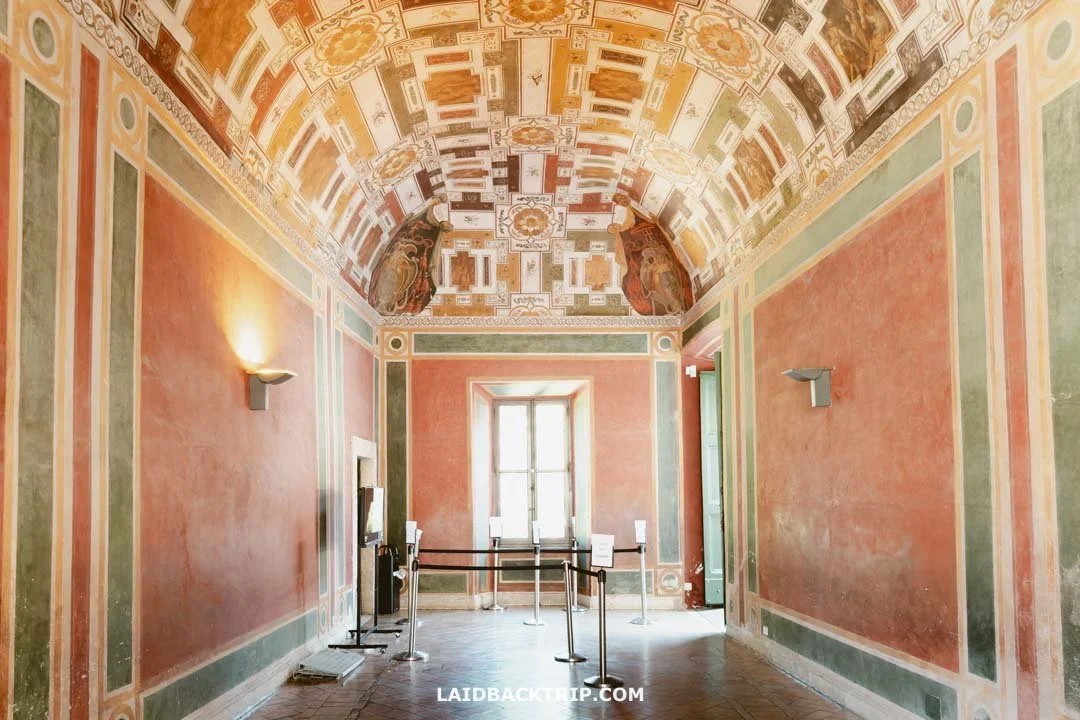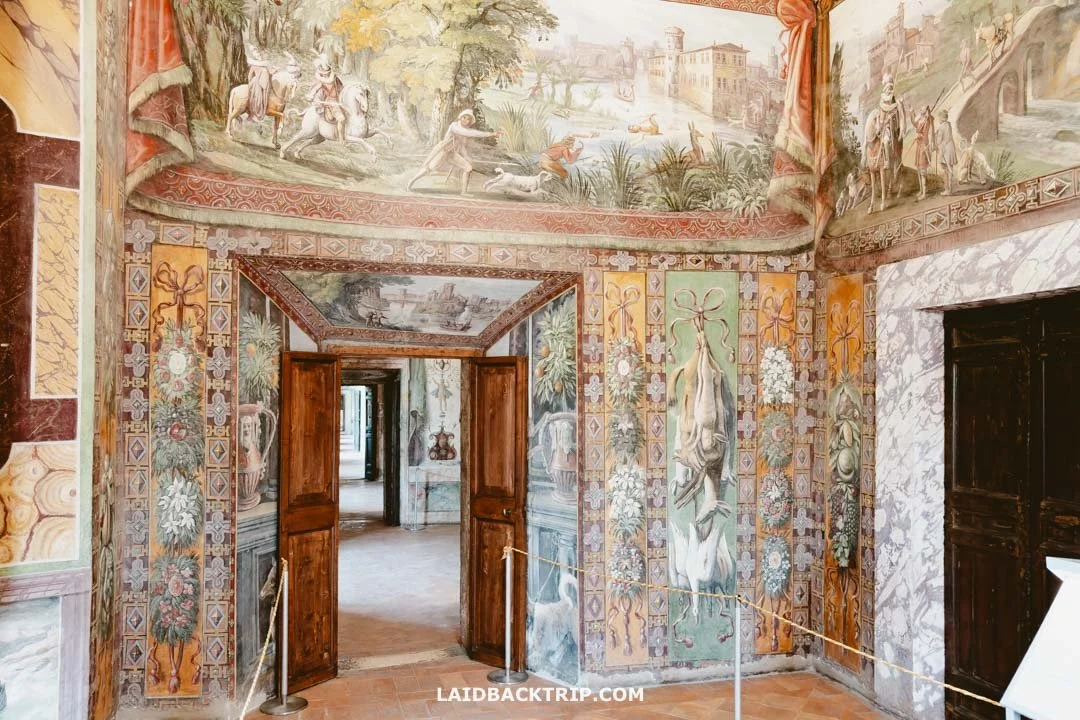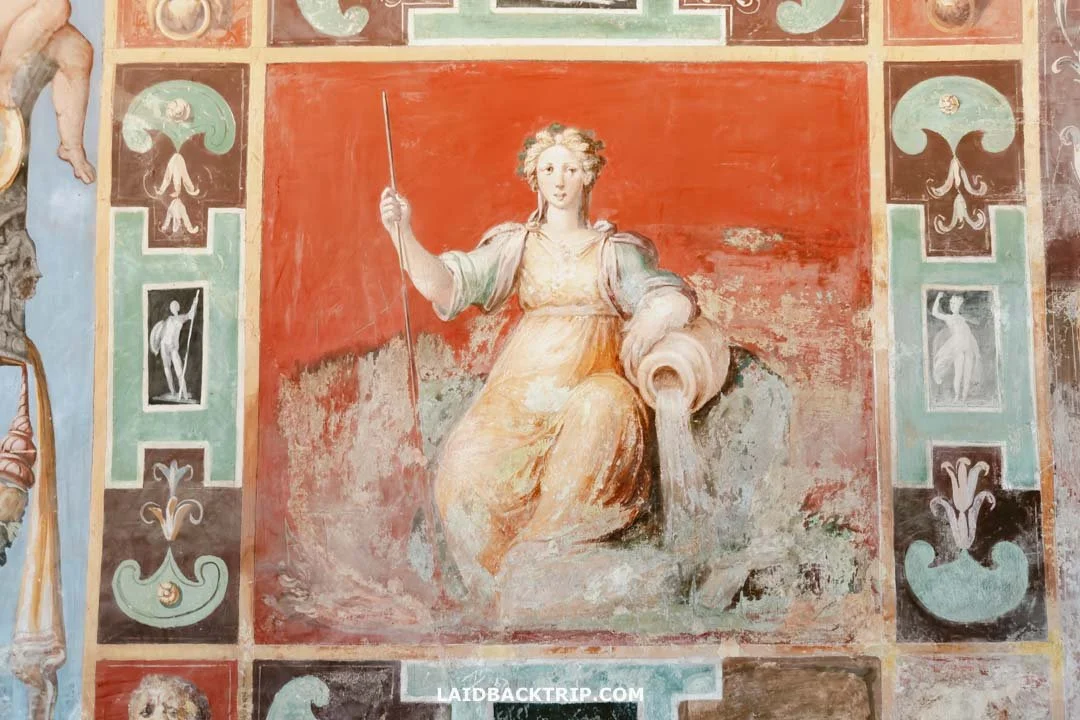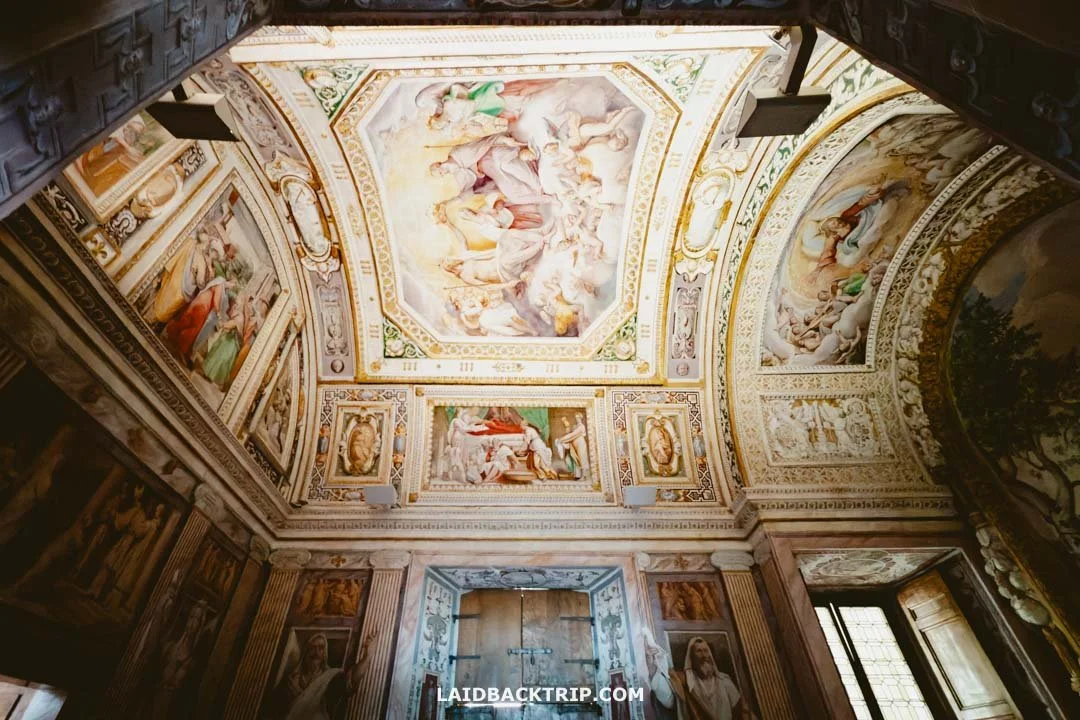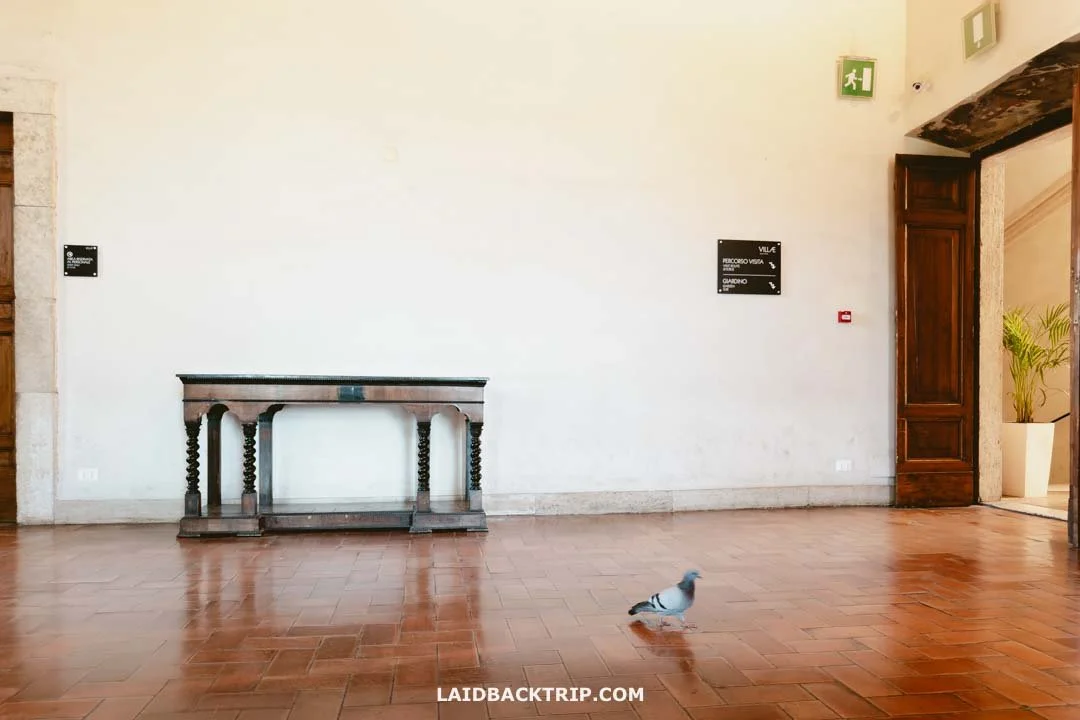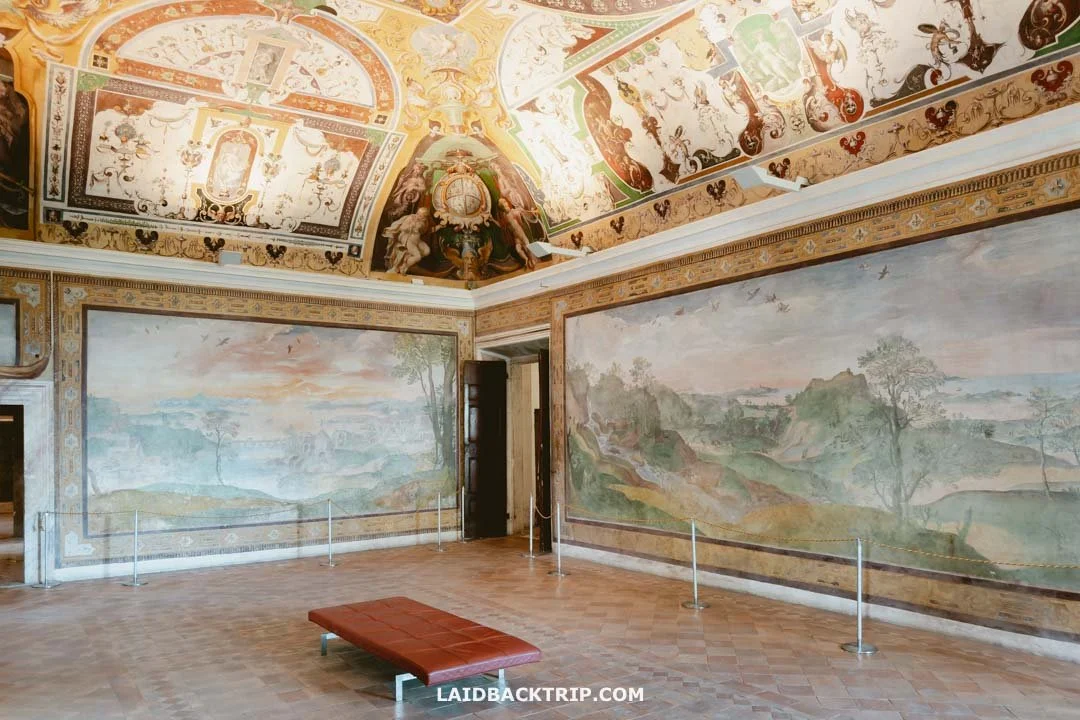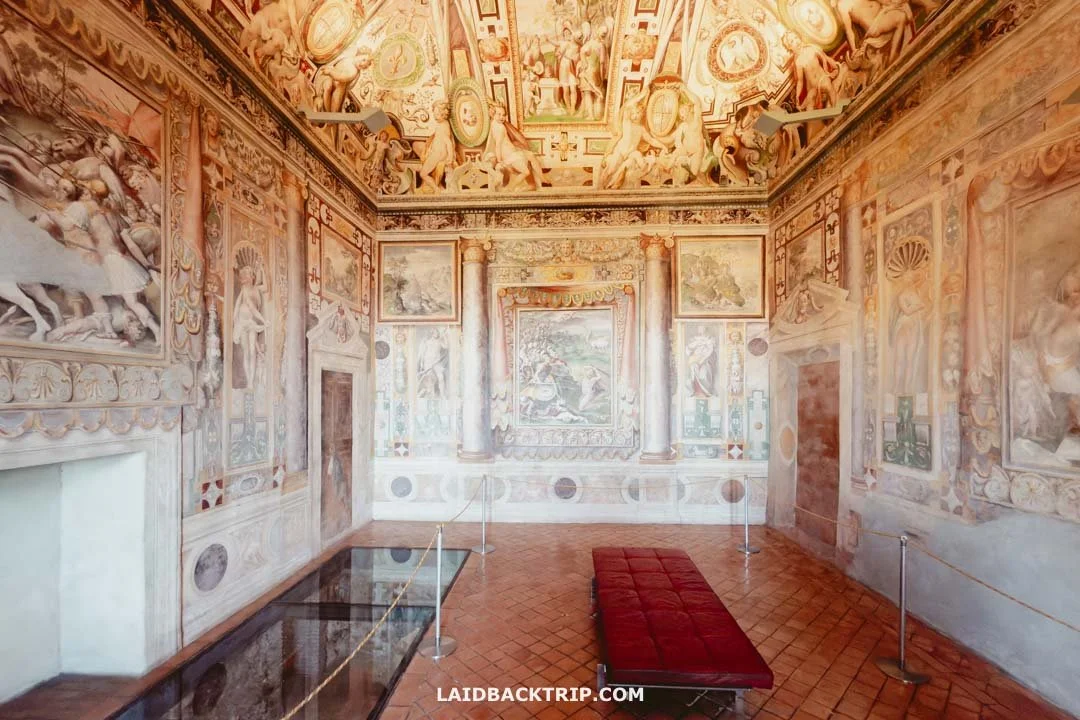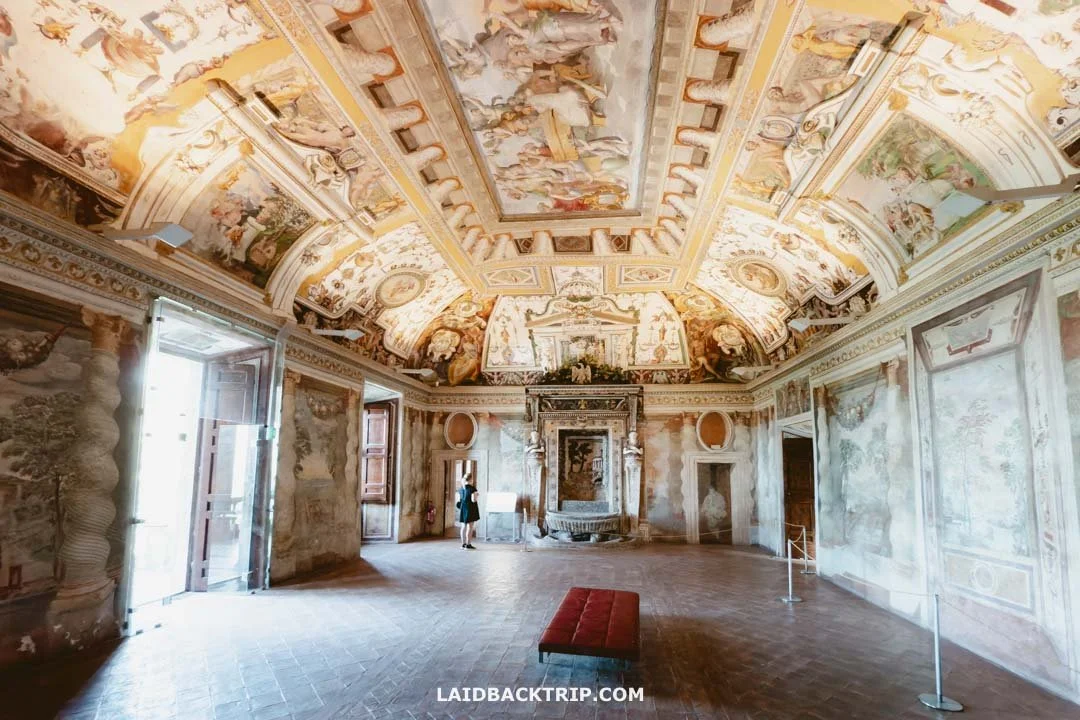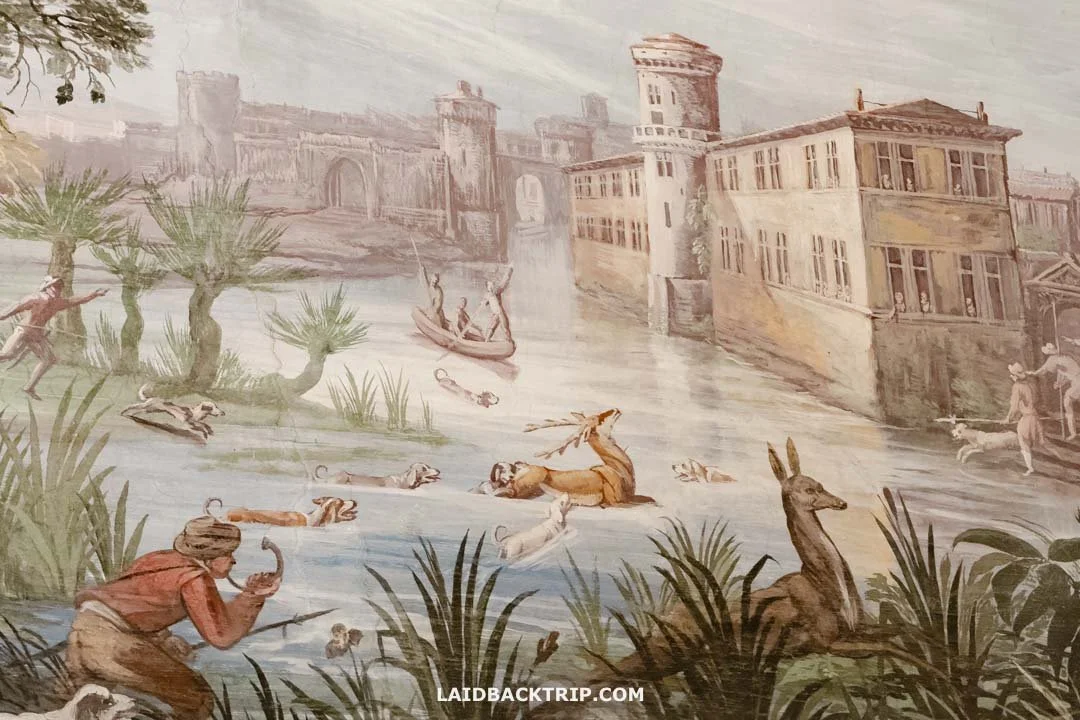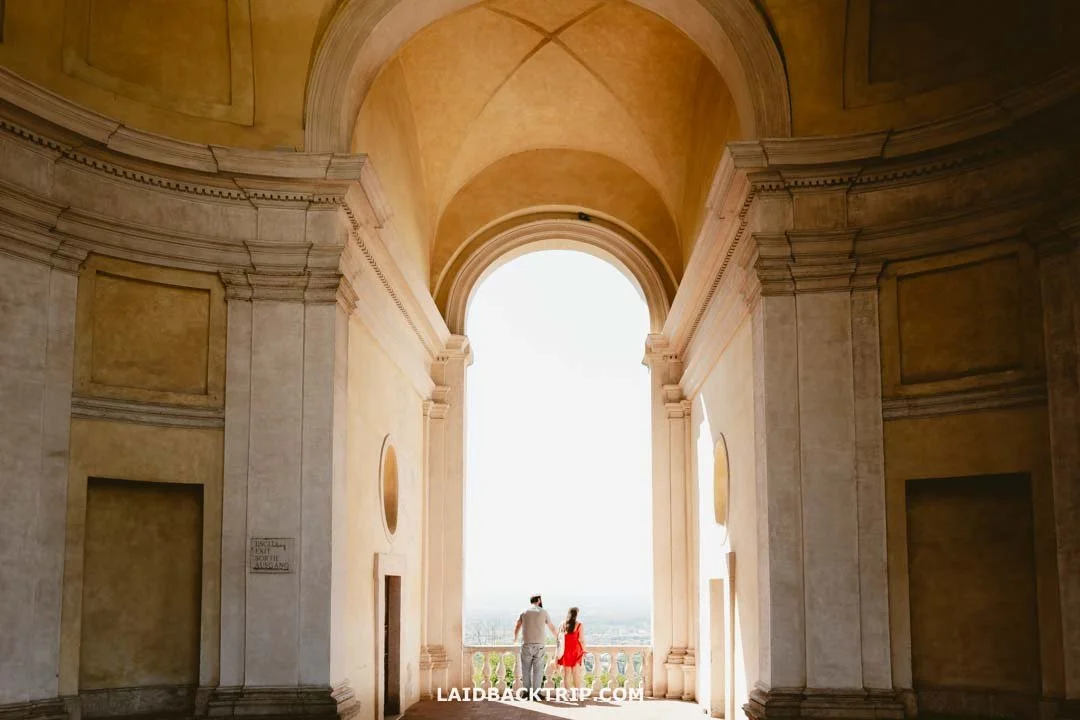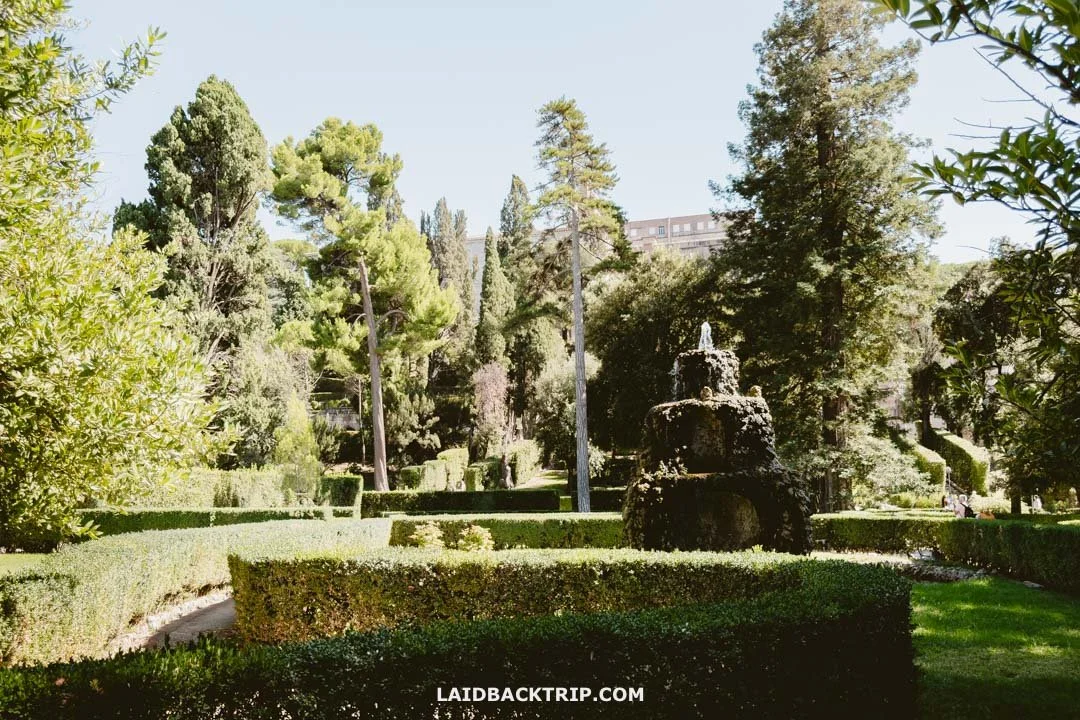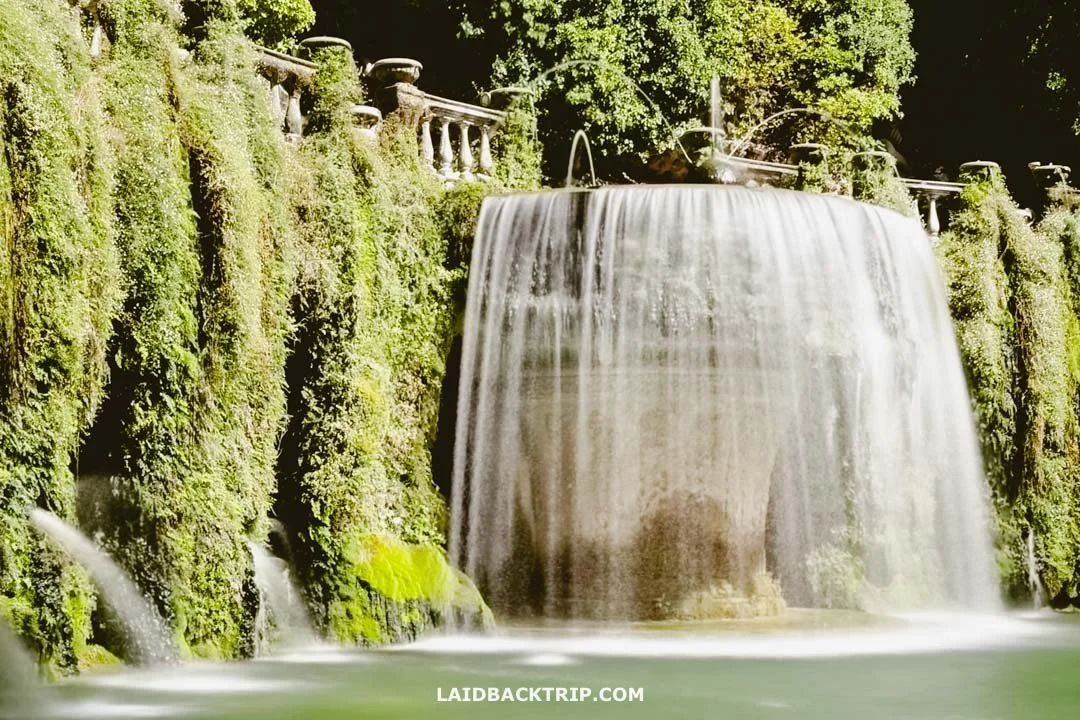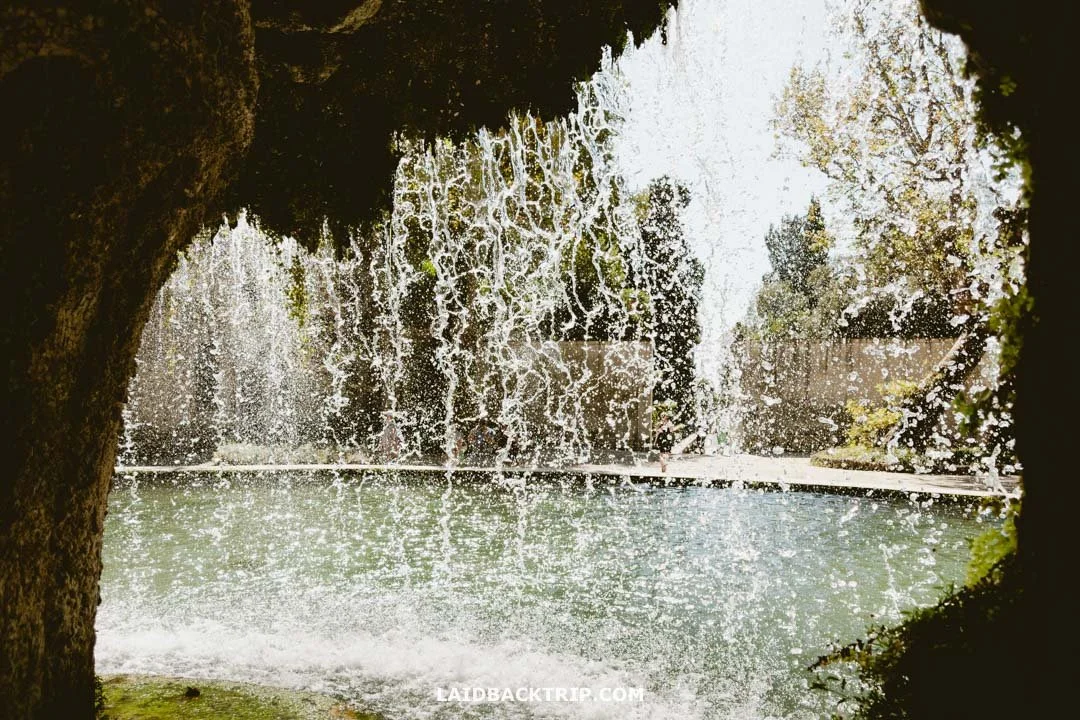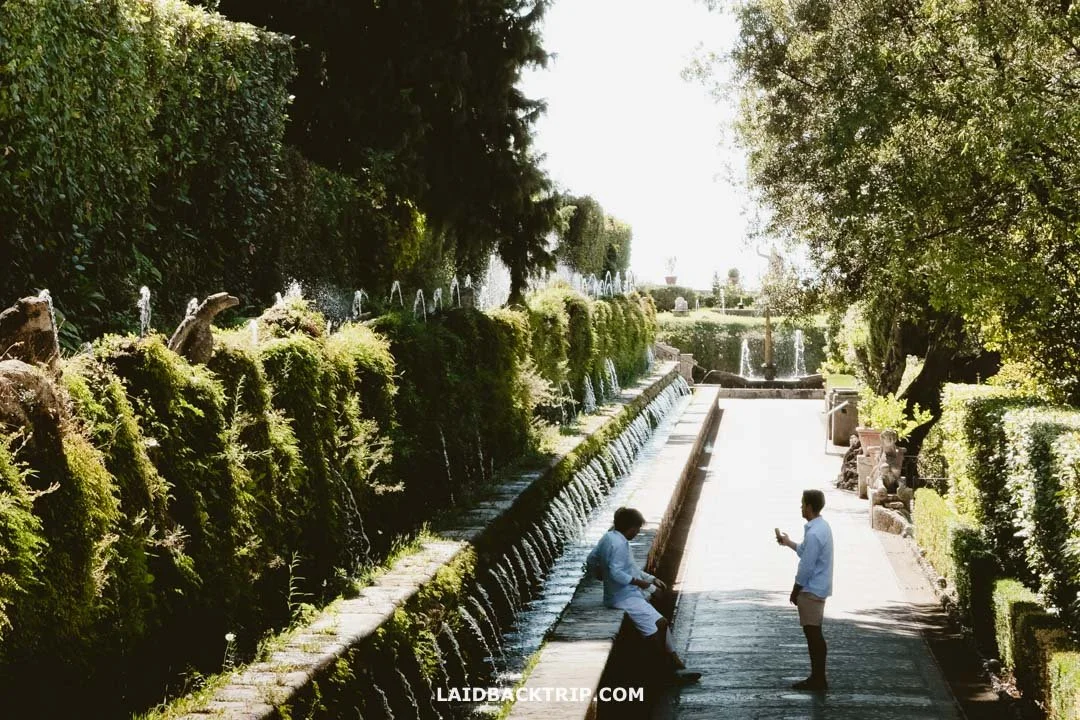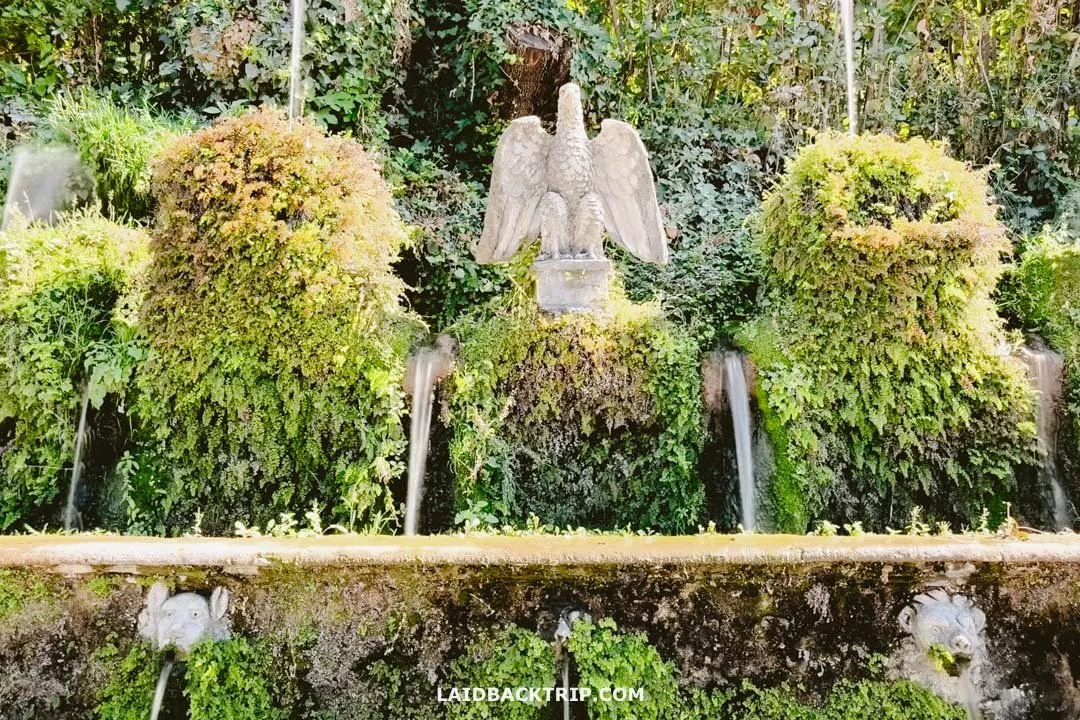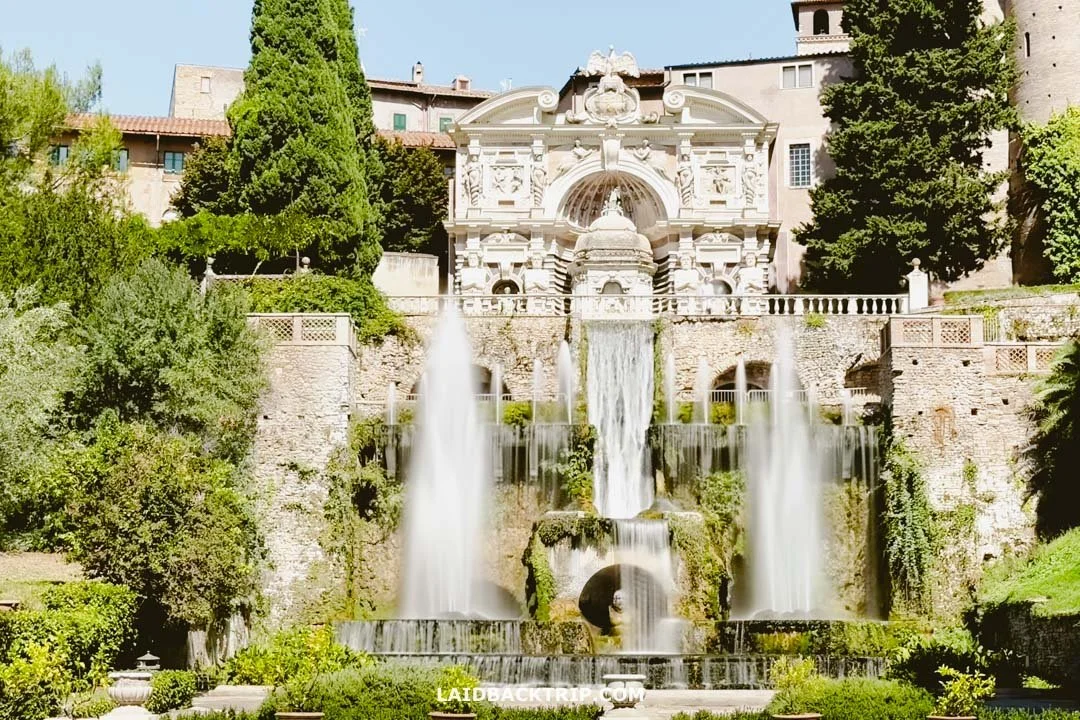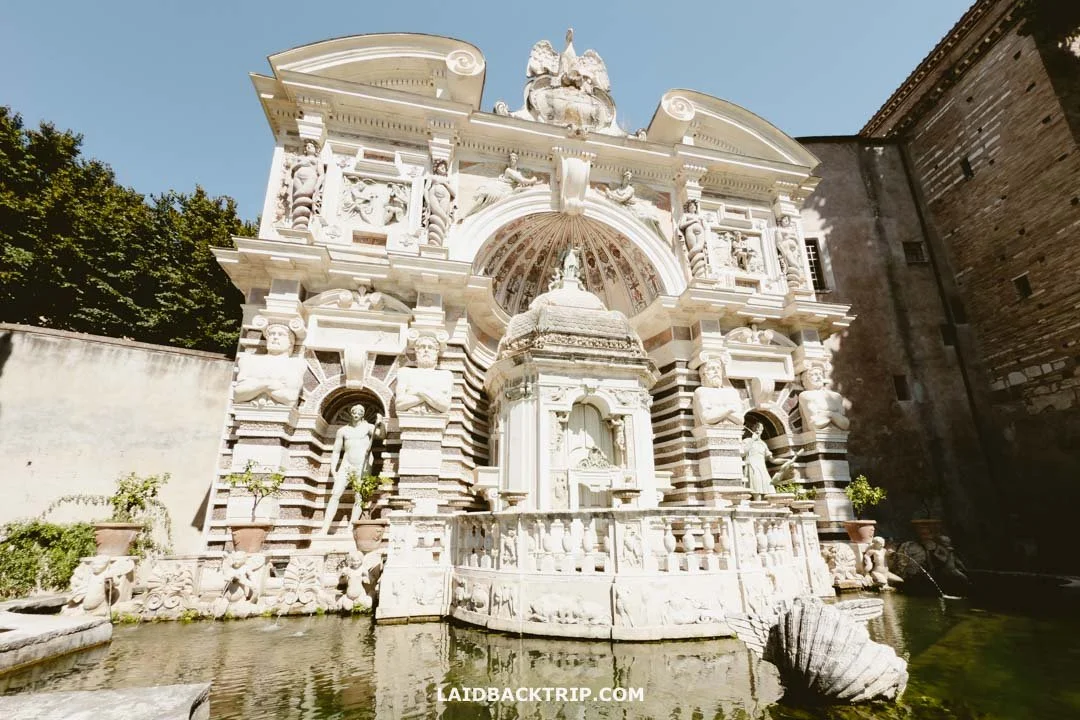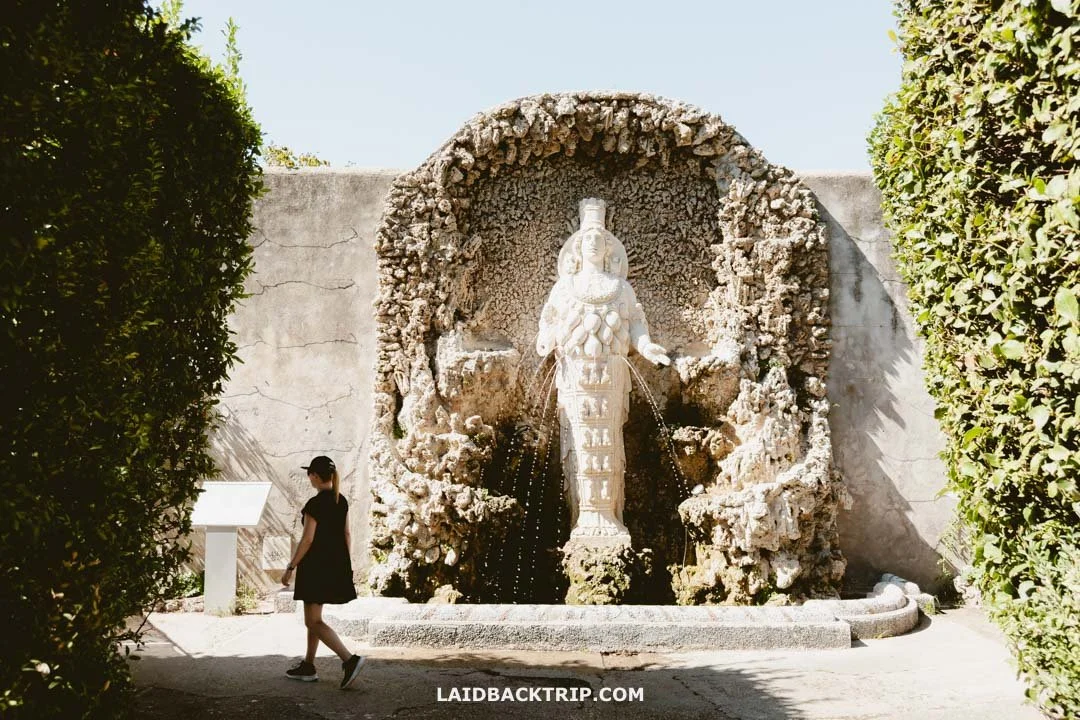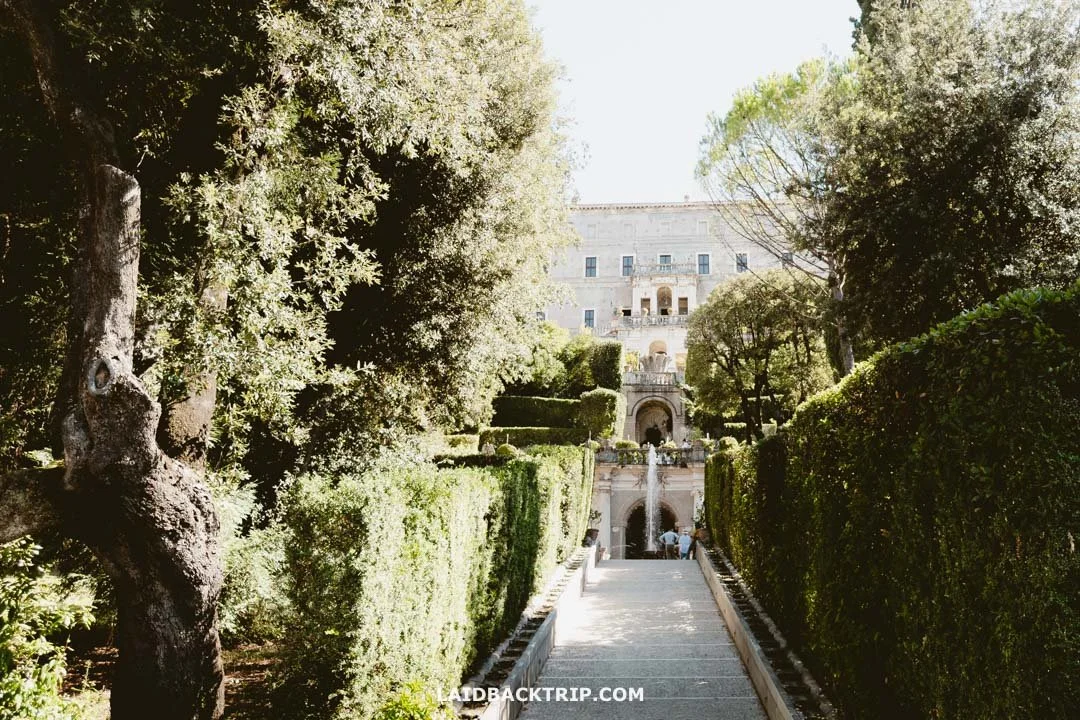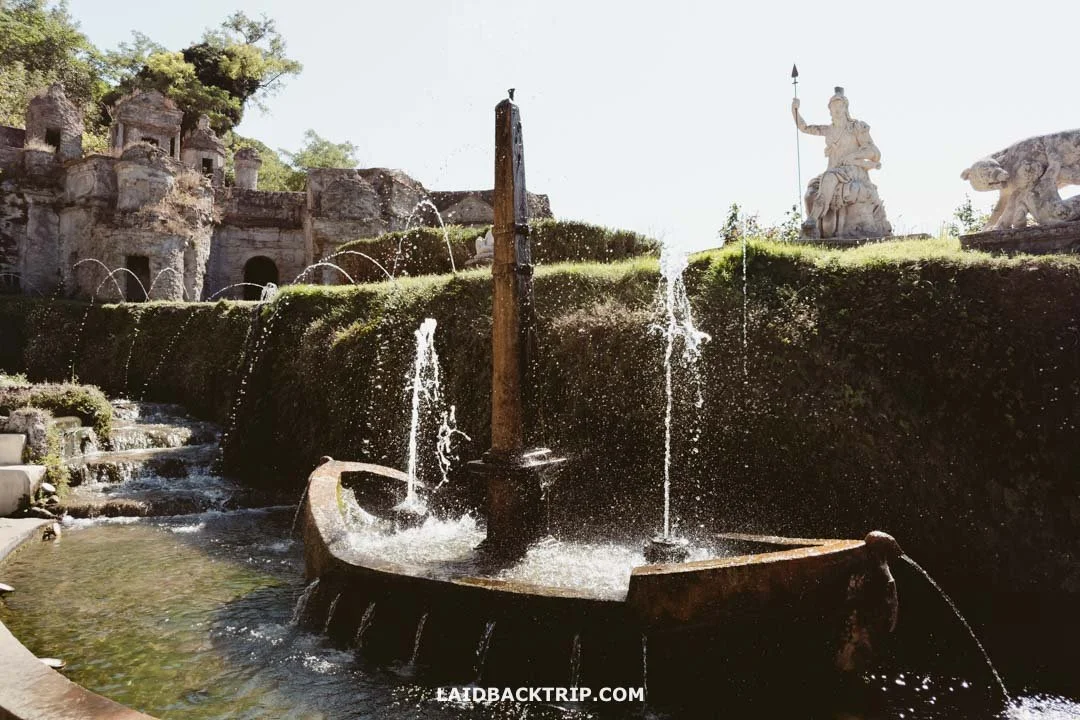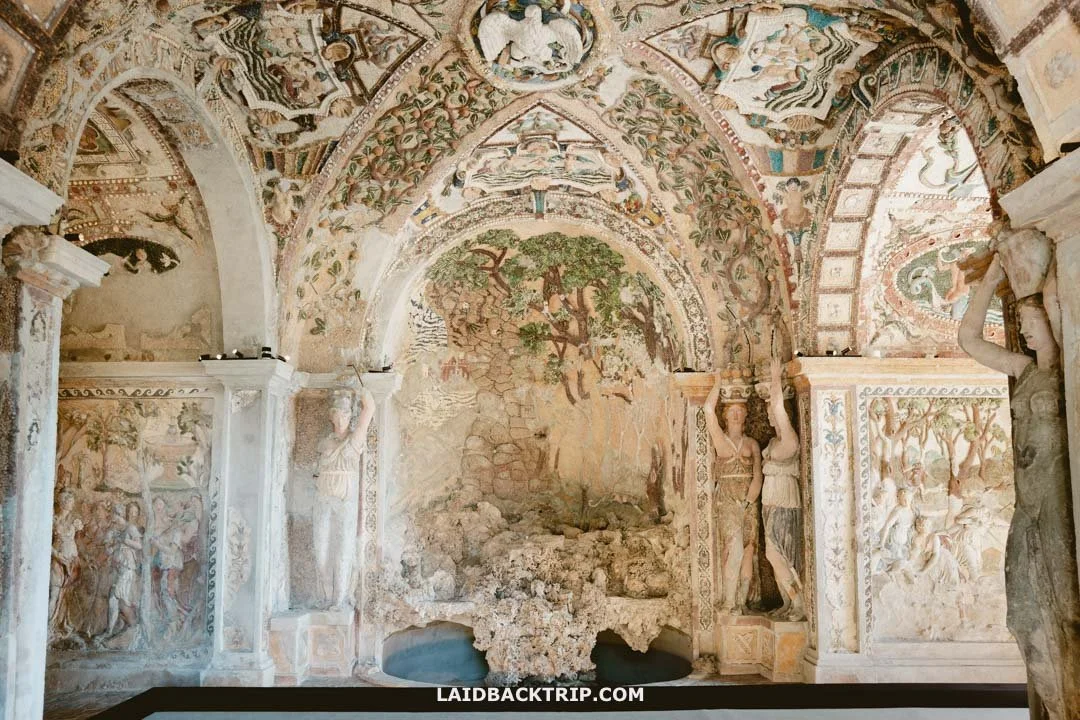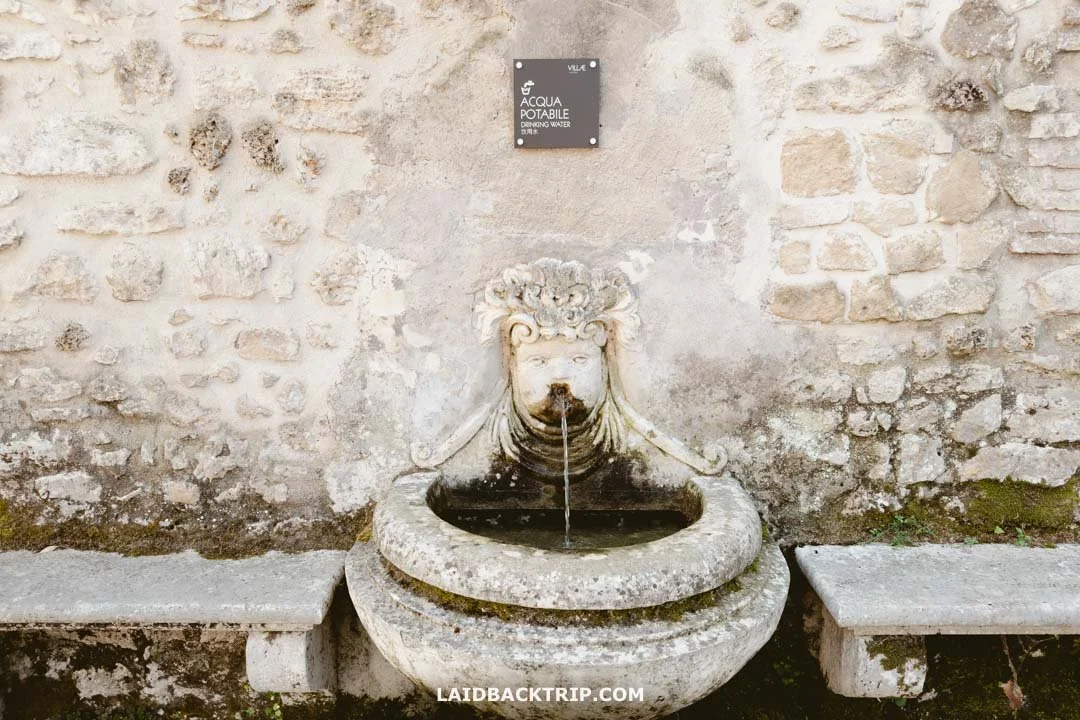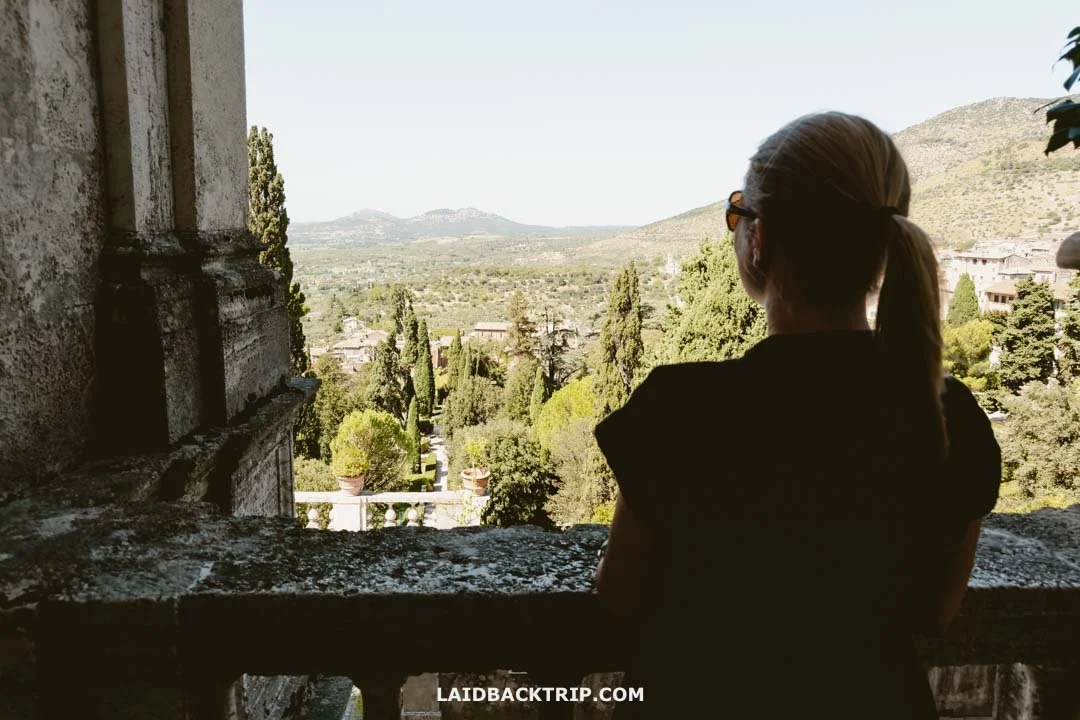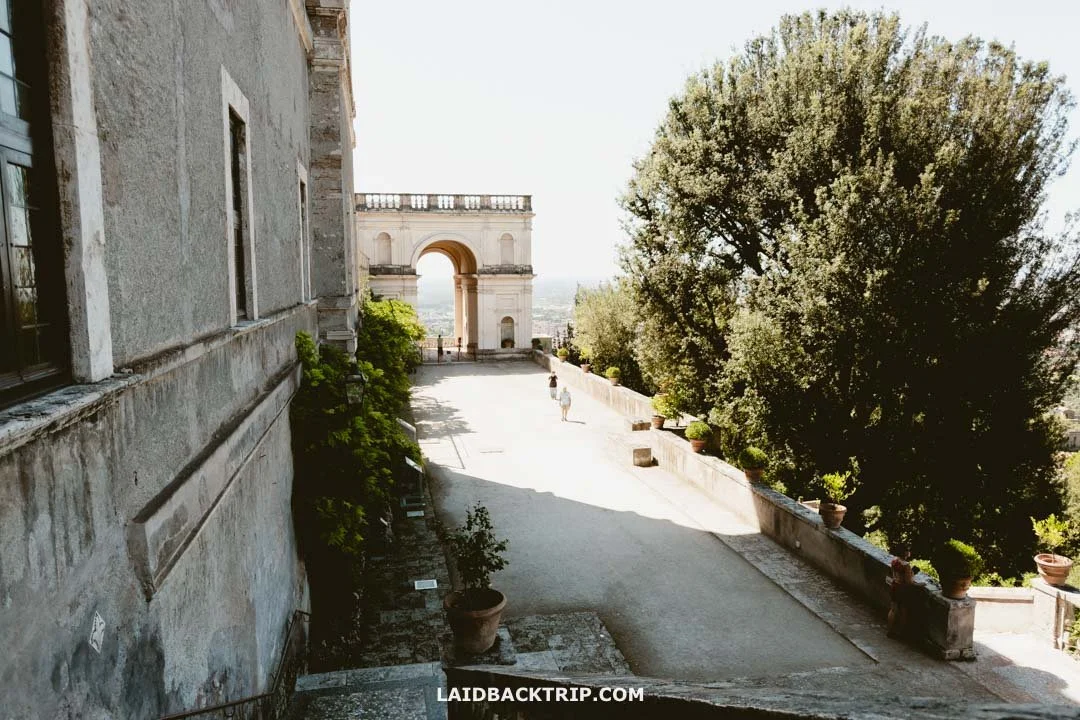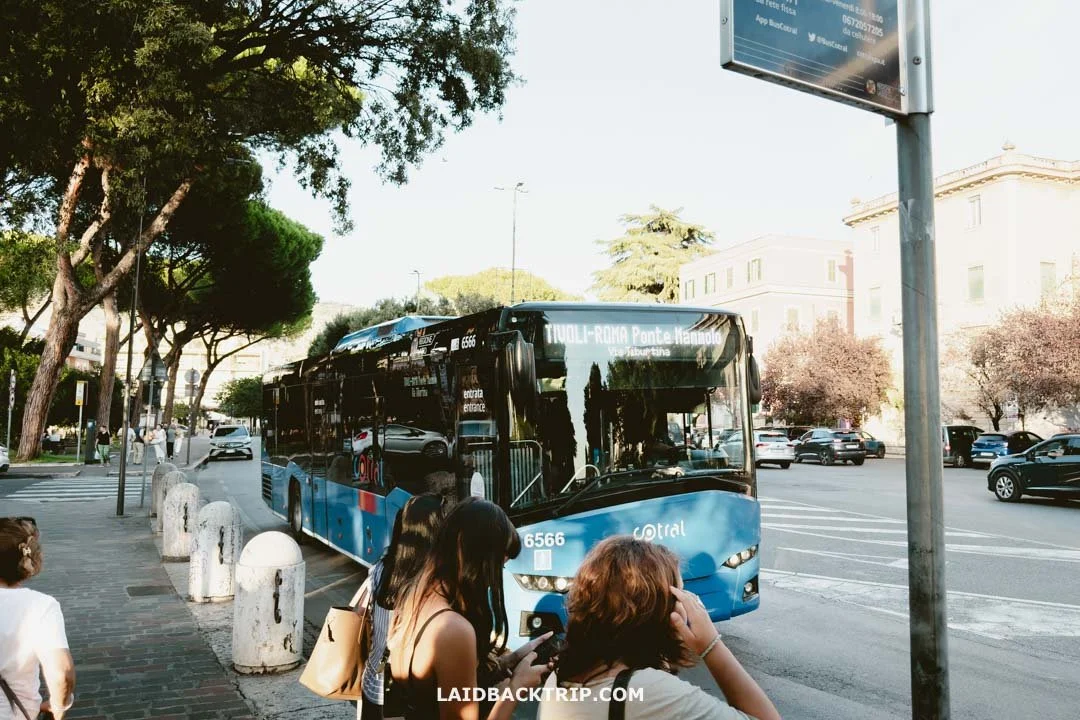How to Visit Villa d'Este in Tivoli
Villa d'Este is home to some of the most beautiful water fountains we've ever seen.
Our next stop in Tivoli was Villa d'Este, one of the main reasons we came to this charming town in the first place.
Villa d'Este is often called the most beautiful place in Tivoli, but after visiting, we'd say that's actually a big oversimplification of what this place truly is. This fresco-filled Italian palace with terraced gardens and stunning water features is a Renaissance masterpiece and the peak of 16th-century hydraulic engineering.
These days, this UNESCO World Heritage site is among the top day trips from Rome because it's just a 40-minute bus ride from the city. That's how it worked out for us. We stayed in Rome for eight days and wanted to see at least one place outside the city. Villa d'Este sounded amazing, at least from the way it was described.
Since we first got to Rome, Lucie had been digging into details about Villa d'Este (and the whole Tivoli area, since this isn't the only must-see there), while I wasn't even sure we'd find the time. In the end, we managed to squeeze it into our jam-packed itinerary, and it turned out to be a fantastic call.
While Lucie already knew a lot about the villa, I only focused on figuring out how we'd get there, which was basically the extent of my knowledge. I really didn't know much about Villa d'Este at all, not its history, not what it was, and not what I'd find inside. Admittedly, when checking which bus we needed, I did see a few photos of the villa with fountains in the gardens.
What I figured out was that this villa was going to be very different from the Roman ruins (Hadrian's Villa) we planned to see first that day, and from Villa Gregoriana, which was on the schedule right after. Still, I mainly went with Lucie's opinion that it would be great. So here's the story of how our trip there turned out.
With views like this, it's easy to understand why Villa d'Este is so popular.
Traveling to Villa d'Este from Rome
Like I mentioned before, our whole Tivoli trip began in Rome. Usually, getting to the Tivoli area with Villa d'Este is super simple, since you can just take a bus or a train. For us, it got a bit trickier because we decided to visit Hadrian's Villa first, but in the end, it wasn't too dramatic. The only thing that changed was that we had to take the bus, because the train doesn't stop there.
From this Ponte Mammolo platform, we caught the Cotral bus that headed to Tivoli’s Villa d'Este.
We started by taking the metro in Rome from Termini to Ponte Mammolo Station, which is where buses to Tivoli depart. From there, we hopped on the Cotral Bus that goes to Tivoli. Normally, this bus runs all the way into the historic center and stops at Piazza Giuseppe Garibaldi, only a short walk from Villa d'Este. But since we had plans to visit Hadrian's Villa first, we got off the bus earlier and didn't continue to Piazza Giuseppe Garibaldi.
Once we wrapped up our morning at Hadrian's Villa, it was time to continue. We were already in Tivoli, but the historic center where Villa d'Este sits was still about 4 kilometers away. The options were clear: either walk or take the bus. Because it was way too hot for walking, we decided to take the bus and got really lucky since one (4X line) was about to leave. We even made a detailed guide for traveling between Hadrian's Villa and Villa d'Este, so you can use it if you want to follow our exact route.
We eventually got off the bus at Piazza Giuseppe Garibaldi.
Once in Tivoli, we found that Villa d'Este sits on the western edge of the historic center, only about 200 meters from Piazza Giuseppe Garibaldi, where the bus dropped us off. That meant we could just walk, which is what we did, though we made a quick stop at a small pizzeria first to grab lunch and cool off in the air-conditioned seating area.
Villa d'Este Tour
If this all sounds like too much hassle or you're short on time, you can definitely take a guided tour to Villa d'Este. The best part of those tours is that they also include Villa Adriana, which, along with Villa d'Este, makes up the top highlights of Tivoli. On top of that, you get commentary from a guide, which is always a plus. Still, we prefer exploring on our own, and our Villa d'Este visit was no exception.
Villa d'Este by Car
Driving from Rome’s city center to Villa d'Este takes about an hour. Renting a car in Rome is generally simple, so apart from traffic, the only tricky part could be finding parking. The villa doesn't have its own lot, but the big Parcheggio Piazza Matteotti is close by, roughly 350 meters from Villa d'Este.
Villa d'Este Tickets
The admission to Villa d'Este was €15 per adult at the time of our visit if you bought a standard ticket. But since we had already gone to Villa Adriana, we had purchased the combo ticket for €30 each, which covered both places along with the nearby Santuario di Ercole Vincitore.
However, because we had just one day in Tivoli, we skipped Santuario di Ercole Vincitore simply due to a lack of time. Looking back, we should have bought standard tickets at each villa instead, since that would have ended up being slightly less expensive.
They also sell tickets to Villa d’Este on GYG that include an audio guide, which can be really handy if you'd rather listen than read.
Once our tickets were checked, we stepped into this beautiful courtyard.
What's There to See in Villa d'Este
Once inside, we quickly saw that Villa d'Este is made up of two areas, the palace and the garden, so it offers both indoor and outdoor experiences. Since we had traveled to Tivoli on our own, we chose to explore the villa without a guide, too.
We figured the palace rooms would have information boards, and we were right. Almost every important room had panels with detailed English descriptions explaining where we were and what to look for. Of course, having a knowledgeable guide might have made the visit more entertaining, but we were satisfied with the written info.
We started inside the palace, walking through a number of stunning rooms, and then continued into the garden, where the famous fountains are. That's the intended way to explore Villa d'Este, and we didn't see any reason to change it. At Hadrian's Villa, we had to adjust the suggested path, but here we simply followed it, since the palace works like a one-way corridor, so there was no point in altering it (we could retrace our steps, though).
Naturally, our visit started at the entrance to Villa d'Este, which turned out to be rather unassuming. It's set on the charming Piazza Trento, right beside Chiesa di Santa Maria Maggiore. We went through the villa's green door and entered the vestibule, where the ticket office is, and immediately saw walls covered in beautiful paintings. It reminded us of entering the House of Augustus on Palatine Hill or a similar Roman ruin. This was in striking contrast with the entrance, which, had we not known it was there, we'd have probably walked right past it without even noticing.
The entrance hall was painted like one of the Roman houses we had seen earlier.
History of Villa d'Este
It wasn't all that surprising since the frescoes and paintings are the main highlight of the Villa d'Este palace. They are a perfect showcase of late Renaissance Mannerist art and were created by a team of leading artists of the era, including Federico Zuccari, Livio Agresti, Girolamo Muziano, and others, all working under the direction of Cardinal Ippolito II d'Este.
Since I just mentioned the cardinal's name, I need to say a few words about Villa d'Este's history and about its founder, because without him, this place would not exist. Cardinal Ippolito II d'Este, born in 1509 into the influential Este family, lived until 1572. He had big ambitions to become Pope, but failed several times.
To make up for his failed papal bids, Pope Julius III appointed him Governor of Tivoli in 1550. Ippolito II d'Este wasn't exactly known for humility, and to display his wealth, prestige, and artistic taste, he decided to construct Villa d'Este. He chose the spot partly because it was near Hadrian's Villa, another extravagant residence built by Emperor Hadrian in the 2nd century CE.
The palace was the part of Villa d'Este where Cardinal Ippolito II d'Este lived.
He began excavating and stripping the Roman site, carrying off marble, statues, and other materials to adorn his villa, aiming to "revive" the magnificence of ancient Rome through his own project. Unsurprisingly, when finished, the villa turned into a lavish cultural center that welcomed some of the most important artists of the late Renaissance.
The detail that impressed us most about the construction is how water is delivered to the villa through a 600-meter underground channel from the Aniene River. Using only gravity and pressure, all 500 fountains, cascades, and jets in the gardens operate without a single pump. Everything runs on natural force alone. But back to the palace for now, since that was our first stop, and the waterworks will have to wait.
The Palace of Villa d'Este
With the history part done, we could finally turn our attention to the villa itself. The confusing thing is that the palace is often referred to as "the villa" or simply Villa d'Este, so in this guide I'll call it the palace to keep everything clear.
The palace in Villa d'Este is all about paintings and frescoes.
Passing through a picturesque courtyard, we entered the palace, which was laid out on two levels. We started upstairs on the second floor in the Cardinals' apartments, then went down to the first floor to see the Nobile Apartment. From there, we descended further to the Gran Viale, which opened up to the garden. Now let's look at what we encountered along the route.
Cardinal's Apartment
It was scorching that day, so when I finally grabbed the paper brochure with the Villa d'Este map, I thought wandering through the palace rooms would be refreshing. But it didn't quite work out that way, since the rooms weren't cool or air-conditioned because of the open windows. It was still warm inside, but at least we managed to get away from the sun for a bit. Given how hot it was, we were grateful for that small relief.
The palace had two main floors, each with rooms decorated in frescoes and paintings, but after a few rooms, we noticed they were less decorated than we had thought. The reason was pretty simple. The second floor had been Ippolito II d'Este's private apartments, with a bedroom, study, chapel, and more modest rooms for his closest staff and family.
Some rooms in the Cardinal's Apartment were still pretty spectacular, though.
This floor wasn't meant to impress guests the way the one below would, which we were about to see next. Still, there were some lovely frescoes and paintings, even though we didn't yet know what was waiting for us. What we especially loved were the views from the windows. Being the highest level of the villa, the second floor gave us the best vantage point. And with Tivoli's stunning scenery, the outlook was nothing short of spectacular.
This table was among the few furnishings inside the Cardinal's Apartments. The pigeon definitely wasn't part of the exhibition.
While walking through the first floor, Lucie pointed out that we hadn't seen any furniture yet. It was a good observation, since ornate furniture is usually a big part of European palaces, estates, and castles (like Neuschwanstein or Versailles). But here there was practically nothing, except for the occasional modern bench where we sat a few times to admire the frescoes. There weren't even statues or clocks, and things like chairs, tables, beds, closets, and small ornaments were all missing.
Even the Borghese Gallery, which focused on sculptures and paintings, had fuller interiors than Villa d'Este. So these rooms felt like the emptiest of all the places we visited in Rome. On the bright side, the lack of distractions meant we could really concentrate on the frescoes and ceilings.
After Cardinal Ippolito II d'Este's death, the villa slowly declined because of the high cost of upkeep, and nearly everything was sold, scattered, or relocated. The only things that lasted were what couldn't be easily removed: the frescoes and, of course, the gardens with their waterworks. It reminded us of Kilkenny Castle in Ireland, which we visited a few years ago, where we heard a similar story.
Noble Apartment
When we came down the steps to the first floor, a long, narrow hallway with a high vaulted ceiling stretched to our left. We skipped it for now and turned right instead, stepping into the Hall of Noah (Sala di Noè). Its frescoes showed the story of the Great Flood and Noah's Ark, complete with painted landscapes and Este lilies designed to look like tapestries.
The Hall of Noah had some truly incredible paintings.
Before moving on, we turned right again and checked out the smaller Hall of Venus and Hall of Moses just around the corner, then continued on to the larger rooms of the first floor.
Next came the Tiburtine Rooms (Sala di Tibur), where the frescoes told the mythical story of Tivoli's foundation and early history, connecting its origins to Greek heroes long before Rome was founded. And yes, Tivoli is actually about 500 years older than Rome!
Tiburtine Rooms showcased the story of Tivoli's founding, which was quite interesting.
Next, we walked into the Hall of the Fountain (Salone della Fontana), where a small fountain stood, decorated with seashells, glass, and mosaics, topped with the Este eagle. This was a reception space meant to connect the palace with the grand gardens.
Hall of the Fountain was designed to impress visitors back then, and it still has the same effect today.
Curious, we stepped outside and found ourselves on top of the staircase. I imagine it did the job really well back in the day. After taking in a different angle of the garden views, we returned indoors. As tempting as it was to go straight down to the garden, we still had a couple of rooms to check out on this floor.
Next, we entered the Hall of Hercules (Sala di Ercole), filled with frescoes of Hercules' famous Labors. As the legendary protector and founder of the Este family, Hercules served as a way to tie the Cardinal's lineage to a powerful ancient hero.
The Hall of Nobility was also really stunning.
We then moved on to the Hall of Nobility (Stanza della Nobiltà), featuring frescoes by Federico Zuccari. In this room, he used trompe-l’œil techniques to create the illusion of architectural depth. The main theme highlighted the Virtues and the Liberal Arts, with Nobility personified to celebrate the Este family's prestige.
After that, we passed through the smaller Hall of Glory (Sala della Gloria), and finally the Hall of the Hunt (Sala della Caccia), which was covered in hunting scenes. At the end of the hallway, we went down another staircase that led us to the Gran Viale, the main garden entrance.
Hall of the Hunt featured, as expected, hunting scenes in its paintings, with plenty of water included.
Travel Insurance
We never leave home without travel insurance that was designed to cover our expenses if something goes wrong during the trip. Travel insurance protects against theft, flight delays, injury, illness, cancellations, and much more. Travel smarter and safer!
World Nomads provides travel insurance for travelers to cover their trip essentials, including sports and adventure activities.
SafetyWing is affordable travel insurance for backpackers, long-term travelers, and digital nomads.
The Garden of Villa d'Este
Once we left the palace, the entire terraced garden stretched out in front of us. Our first stop was a walk along the Gran Viale, the highest level, where we got stunning views of both the gardens and the Tivoli surroundings.
We had already admired the views from the palace windows, but they were something we just couldn't get enough of. Before going deeper into the gardens, we stopped at the Gran Loggia, a large arch on the left, and once again, the views were nothing short of amazing.
Gran Loggia offered some truly stunning views of Lazio.
Since it was past noon, we'd been on our feet since early morning, and had bellies full of pizza, the garden felt like the perfect place for a short break. Luckily, we found a quiet bench where we spent about 15 minutes just soaking in the view, maybe even closing our eyes for a minute.
After a few minutes, though, we realized we weren't the only ones who thought the shaded bench was a good spot. A swarm of local mosquitoes claimed it as theirs, and after a couple of itchy bites, we had to retreat back into the sun since we hadn't packed any bug spray. Back on our feet, we left the rest of the break for another time and kept exploring.
Here's a fun fact. Villa d'Este's garden is often referred to as Tivoli Gardens, but that's also the name of the iconic amusement park in Copenhagen. So if you just type "Tivoli Gardens" into a search bar, you might get pointed to Denmark instead of Italy. Anyway.
The terraced garden can be split into three parts: the upper, middle, and lower levels, plus the Grand Avenue (Gran Viale) up top. At first, we did our best to follow the route suggested in the paper brochure, though after a while, we ended up making quite a few changes.
Here's the view from the bottom terrace of Villa d’Este’s garden.
The garden was gorgeous, and since it wasn't that big, we kept wandering off the planned route whenever something caught our eye, which happened pretty often. At least we tried to stick to each level at a time, so we didn't have to constantly climb up and down.
Below, we've listed some of the most striking fountains we saw in the garden, though these are only the major ones since there were many smaller ones too. If you've got extra time, the garden is ideal for ditching the paper map and just wandering around, since there's no way to really get lost.
The Oval Fountain (Fontana dell'Ovato)
Luckily, the first fountain we stumbled upon in the garden was so impressive that our fatigue vanished right away. This was the Oval Fountain, and even at first glance, it stood out as one of the most beautiful fountains in Villa d'Este.
The Oval Fountain was just gorgeous.
The best part of the Oval Fountain was that we could walk behind the waterfall. It was such a fun experience that as soon as we stood behind the stream dropping into the pool, Lucie said it reminded her of Seljalandsfoss, only much smaller. The difference was that here we stayed dry, and the whole thing felt far less intimidating.
Here's the view from the cute grotto behind the Oval Fountain.
The Hundred Fountains (Le Cento Fontane)
Before heading down to the central area of the garden, we turned back to explore the Hundred Fountains. This is another of the garden's iconic water features and a great example of how the system works in Villa d'Este. At first glance, it didn't seem as grand as the Oval Fountain we had just seen, but it was still fascinating.
The Hundred Fountains is essentially a promenade over 100 meters long that runs between the Oval Fountain and the Fountain of Rometta. We only reached Rometta much later, though, since we ended up circling the garden in a counterclockwise direction.
The Hundred Fountains features over 300 spouts, all powered by natural water pressure and ingenious engineering.
This fountain is built from three parallel canals set in a terraced wall, with over 300 spouts shooting water. At first, I wasn't too interested. Coming from the eastern side, it didn't seem that exciting, but Lucie persuaded me we should give it a closer look.
It turned out to be pretty impressive, especially considering its length and the sheer number of spouts. The fountain was decorated with lilies, eagles, obelisks, and little boats, all symbols tied to the Este family's coat of arms.
The fountain stretched on for what felt like forever, and although we didn't walk all the way to the far end, we still spent a good amount of time there. We skipped crossing to the other side for now, knowing we'd end up there later after seeing the lower garden.
Water Works in Villa d'Este
One thing we thought was pretty cool is that, because of Tivoli's mild climate and the gravity-fed system, the fountains don't get shut off in winter the way they do in some colder destinations we've been to.
Take our Bavaria road trip last year as an example. Even though it was mid-spring, the fountains were still off. We saw stunning gardens at places like Linderhof Palace and Bayreuth Hermitage, but the water features were completely dry.
There are several hundred water features at Villa d'Este.
That definitely took away some of the magic, but this isn't the case at Villa d'Este. Of course, they still do maintenance sometimes, which means the fountains get turned off, and after heavy rains, the Aniene River can swell, which can also stop the water. So it's smart to check the weather before visiting.
When we visited in early September, the weather was sunny, all the fountains were running, and the Aniene River was calm with a low water level, so everything worked just fine.
The Neptune Fountain (Fontana di Nettuno)
In the past few days exploring Rome, we'd already seen some amazing fountains, like the stunning Fontana dei Quattro Fiumi or the iconic Fontana di Trevi. After a few minutes in Villa d'Este's gardens, we could add even more to that list. And the Neptune Fountain was easily one of the most beautiful we've ever seen.
The Neptune Fountain is easily the most beautiful fountain in Villa d’Este.
Approaching the Neptune Fountain from the higher terrace, we got to see it from above for the first time. The water shot up impressively, and the middle of the gardens spread out before us. It was easily one of the most breathtaking views in the entire garden.
We then descended to its base, and this time we could enjoy the whole spectacle from the front. We stayed here for a few minutes, as the Neptune Fountain was definitely the highlight of our garden visit.
The Water Organ (Fontana dell'Organo)
While standing above the Neptune Fountain, we were also right in front of the Water Organ, another famous fountain at Villa d'Este. This one is very different from the others. It sits inside a grand, elaborately decorated structure, though that's not what makes it so special.
The Water Organ plays music using water pressure, though we didn't get to see it.
Inside is a true Renaissance engineering marvel. Water pressure powers a hidden mechanism that plays a real, resonating hydraulic organ. Back in the day, it was quite an achievement. Today it runs daily, usually every two hours. We missed it by just a few minutes, and waiting almost two hours wasn't an option. If you don't want to miss it, the first show is at 10:30, and then it follows the two-hour schedule.
The Lower Part of the Garden
Technically, we then descended to the Neptune Fountain. But here, we continue on to the lowest garden area since we had already covered it. This part was the quietest, with no large fountains, but there were several small, delightful ones, including the Fountain of the Winter and the Fountain of the Eagles.
We had to walk down to the lowest point of the garden to see the Fountain of Mother Nature.
The most memorable was the Fountain of Mother Nature, featuring a 16th-century copy of the multi-breasted Diana statue, a symbol of fertility and abundance. Then we reached the southwestern tip of the garden, where the Fountain of the Swans stood. From there, it was an uphill walk back to the palace.
Fountain of the Dragons (Fontana dei Draghi)
We stopped again at the fish ponds, which we had mostly skipped earlier. From this angle, the views of the ponds with the Neptune Fountain behind them were incredible. Since the fountain was far across the whole garden, we walked back toward the middle to get a better view.
The palace of Villa d'Este towers above the Fountain of the Dragons.
From here, it was easy to reach the Fountain of Dragons next. This famous fountain is known for its four winged dragons, each spouting water into a big basin, with a central jet soaring high. Once again, it shows off the villa's water system, as everything works entirely from natural pressure.
Fountain of Rometta (Fontana di Rometta)
After that, we headed back to the western side of the garden, where a few more fountains awaited, including the Fountain of the Owl and the Fountain of Proserpina. All of these fountains were impressive, but the Fountain of Rometta was easily my favorite since it felt so different from the mostly traditional ones. It represents Rome and the Tiber River, shown with a small boat, and has a stunning design.
The Rometta fountain looked totally different from all the others.
The Grotto of Diana (Grotta di Diana)
Just when we thought we were finished, we entered the Grotto of Diana. This elaborately decorated nymphaeum, with marine scenes inspired by Ovid's Metamorphoses, was created as a calm, contemplative space honoring the goddess Diana. Interestingly, it had been closed for a long time and reopened just a few months before our visit. After exploring it, we took the exit staircase and returned to the main courtyard.
The Grotto of Diana was reopened to the public in 2025.
How Much Time to Spend in Villa d'Este
It took us just over two hours to see almost everything at Villa d'Este, and I'd say we moved at a pretty relaxed pace. The palace wasn't tiny, but it also wasn't huge, and I'd say the same about the gardens. When I was editing photos for this post, I checked the timestamps and saw we spent about an hour in the palace and another hour in the gardens. There was extra time for tickets, restroom breaks, and so on, but it didn't add much to the overall visit.
Since we had only one day in Tivoli, we wanted to make the most of it. I'd say a two-hour visit reflects a fairly typical tourist experience. We didn't rush, but we also didn't spend forever staring at a single fountain. We could have easily lingered another hour or two in the garden, enjoyed the Water Organ show, or grabbed a snack at the on-site cafe, but as I said, we simply didn't have time.
Our tip: If you're planning to spend more time at Villa d'Este, bring a water bottle. We carried ours and refilled them whenever we wanted at one of the many fountains with drinkable water around the garden.
We refilled our water bottles at this cute water fountain.
There's actually plenty to do in Tivoli beyond Villa d'Este, especially if you only have one day. Our schedule was full but manageable, and we saw a lot. We still missed a few spots and kind of wished we could spend the night, as the whole historic town, not just the villas, is incredibly charming.
Tips on Accommodation: Tivoli has some nice hotels if you want to stay overnight, like Al Palazzetto and Palazzo Santori. We had to get back to Rome, though, and if you're curious where we stayed, it was at the lovely Leonardo Hotel.
Is Villa d'Este Worth Visiting?
Villa d'Este was a lot of fun to explore, and we really enjoyed the entire experience. The palace rooms had stunning paintings and amazing views of Tivoli, while the gardens contained some of the most beautiful fountains we've ever seen, especially in such a compact area. Overall, the mix of the Renaissance palace and the gorgeous gardens was fantastic, and very different from the Roman ruins we saw that morning, as well as the waterfall park we planned to visit next.
Villa d'Este is not just about frescoes and water works, but also has gorgeous views.
Another thing we quickly noticed was how surprisingly pleasant and peaceful the site was. Small, easy-to-reach UNESCO sites like this often get crowded, but even though we visited on a weekend, Villa d'Este didn't feel that way. Sure, it was a bit busier than Hadrian's Villa, but we could understand why. The Roman site is much bigger, so visitors can spread out more, and it's also slightly harder to reach, being farther from the town center.
Whatever the reason, Villa d'Este was a pleasant surprise in that way, and really in almost every other respect as well. One of the most fascinating things we learned was how the water features actually work, even though we could only see the final effect. It was another piece of the puzzle for our day in Tivoli, and that's why we believe Villa d'Este is absolutely worth a visit.
Villa d'Este Opening Hours
We visited Villa d'Este during the main season, which runs from late March to mid-September, and the opening hours were 8:45 AM to 7:45 PM. The last admission was at 6:45 PM, and the garden closed at 7:30 PM.
For the rest of the year, the villa still opens at 8:45 AM, but the closing times change. In spring and fall, it usually closes at 6:45 PM, while in winter, it can close as early as 5:15 PM because of the shorter days.
In summer, Villa d'Este stayed open for long hours.
Heading Back to Rome from Villa d'Este
Once we finished at Villa d'Este, we explored the historic center and then visited Villa Gregoriana. In the late afternoon, we made our way back to Piazza Giuseppe Garibaldi to take another walk through the old town before returning to Rome.
Finally, we caught a bus back to Rome from the Piazza Garibaldi (Villa d'Este) stop. Google Maps was about 50 meters off from the actual stop, so the correct GPS coordinates are 41.96045, 12.79547. The stop had a shelter with a blue Cotral sign, and to be certain, we double-checked with a local who was waiting there too.
Since we already had Cotral tickets from the morning, we didn't need to worry about buying new ones. In case you don't have tickets, we spotted a little tabacchi shop just across the road, right on the corner of Viale Mannelli.
We took this Cotral bus back to Rome.
Travel Resources
Here you can find links to all the travel resources we use and which you might find helpful when planning your next holiday.
Accommodation: When looking for accommodation, we usually search hotels via Booking.com or Hostelworld.
Tours: Although we love to travel independently, some places are better to visit with a guided tour.
We prefer GetYourGuide for its easy-to-use interface and solid reputation. Another great alternative is Viator.
Rental Cars: When going on a road trip, we always use Rentalcars.com, a reliable site for booking a rental car in advance.
Flight Tickets: When looking for flight tickets, you can search Skyscanner to find the best price.
Travel Insurance: World Nomads and SafetyWing cover against risks of travel.
